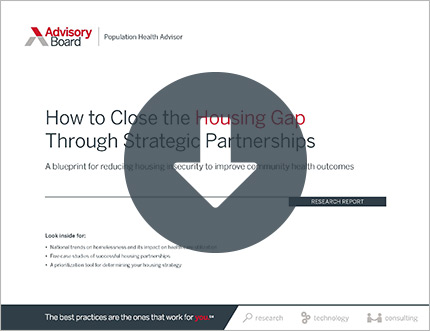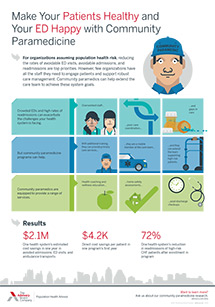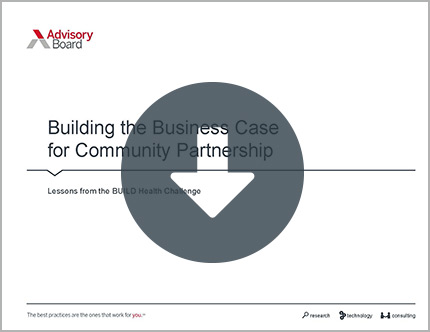Auto logout in seconds.
Continue LogoutEditor's note: This popular story from the Daily Briefing's archives was republished on Dec. 17, 2018.
Over the last decade, Nationwide Children's Hospital has invested more than $6 million in the nearby Southern Orchards neighborhood in Columbus, Ohio—and the arrangement has turned out to be a "win-win" for the hospital and its patients, Paul Chisholm reports for Kaiser Health News.
The neighborhood of Southern Orchards
According to Chisholm, in the 1990s, about half of the children living in the Southern Orchards neighborhood lived in poverty. The circumstances arose from "years of divestment in housing and other services," according to Jason Corburn, a professor at the University of California-Berkley.
Michael Doody, a resident of the community, recalled "gunshots, helicopters, thefts, smashed-out windows, burglaries, robberies, assaults, and murders."
Kelly Kelleher, director of the Center for Innovation in Pediatric Practice at Nationwide Children's Hospital, said that one consequence of the violence was that many kids stayed at home, which created its own health risks. "Kids get trapped inside their apartments," Kelleher said. "There's a lot of violence outside, and they watch TV all the time. They overeat. They have asthma."
A lot of the children in Southern Orchards, a predominantly black community, lived in "houses that are falling apart" and have mold, rodent infestations, and plumbing issues, Kelleher said. These circumstances—combined with the overall stress of living with violence, trauma, unstable living conditions, poverty, and racial discrimination—creates a so-called "neighborhood effect," wherein a child's community damages their health.
Nationwide Children's invests in 'healthy neighborhoods'
In 2008, Nationwide Children's Hospital launched the Healthy Neighborhoods Healthy Families (HNHF) initiative in Southern Orchards to address the "neighborhood effect" through an investment investing in neighborhood housing.
A summary of the project's work so far ran in the journal Pediatrics in August. To date, HNHF's efforts include renovating 71 old homes, constructing 58 affordable housing units, building 15 new homes, and providing 149 grants to homeowners for renovation. "Most [houses in the neighborhood] were in such bad repair," Doody explained. "But they came in and they worked within those homes and they didn't tear them down."
The HNHF project was a partnership with city and community groups, and it cost more than $22 million. Kelleher said the hospital put $6.6 million into investing in "the neighborhood as a patient."
For Nationwide Children's Hospital, the investment made financial sense. The hospital covers 300,000 children on Medicaid through its ACO, and it is reimbursed based on the number of patients under the program rather than by individual services delivered. Nationwide Children's CFO Tim Robinson, the arrangement is a "win-win" because the "more efficient, better aligned model" can improve patient health, and profitability for hospitals and insurers, while simultaneously decreasing state Medicaid expenditures.
According to Kelleher, providing children with better housing works as preventive care, combatting the root causes of ill health and keeping the children out of the hospital. "It's remarkably frustrating as a physician to see patients over and over and over again from these very high-risk communities," Kelleher said.
Experts think Nationwide Children's $6.6 million investment will pay for itself if it lowers hospital visits from children in Southern Orchards. "If we are able to show these improvements [in health] and reductions in utilization, it will be a financial benefit," Kelleher said.
HNHF results in benefits for patients and hospitals
To gauge its progress, the hospital is measuring how "the number [ED] visits, inpatient days, and... problems ...present[ed] to the hospital," have changed since 2008, Kelleher said. It will still take some time for these metrics of health outcomes to reflect the results of the investments, but Kelleher has seen improvements in the Southern Orchards neighborhood in recent years. "The number of murders has gone down in our neighborhood dramatically. It used to be a very big problem," Kelleher said. "High school graduation rate has also gone up."
Doody, who has lived in Southern Orchards for over a decade, cites similar changes, saying the neighborhood is more "family friendly" than it was in the past. "I see couples, families, dogs out casually walking through the streets till 11 o'clock at night."
While some residents have expressed concerns about possible gentrification, Kelleher said the hospital is "aiming for... a mixed-income sustainable community," which may include rent-controlled units for low-income renters (Chisholm, "Shots," NPR, 8/19).
Explore 4 steps for building effective community partnerships
To be successful, population health programs must invest heavily in partnerships with local organizations and health departments.
Learn how to develop and leverage these partnerships to address the root causes of local health challenges.
Don't miss out on the latest Advisory Board insights
Create your free account to access 1 resource, including the latest research and webinars.
Want access without creating an account?
You have 1 free members-only resource remaining this month.
1 free members-only resources remaining
1 free members-only resources remaining
You've reached your limit of free insights
Become a member to access all of Advisory Board's resources, events, and experts
Never miss out on the latest innovative health care content tailored to you.
Benefits include:
You've reached your limit of free insights
Become a member to access all of Advisory Board's resources, events, and experts
Never miss out on the latest innovative health care content tailored to you.
Benefits include:
This content is available through your Curated Research partnership with Advisory Board. Click on ‘view this resource’ to read the full piece
Email ask@advisory.com to learn more
Click on ‘Become a Member’ to learn about the benefits of a Full-Access partnership with Advisory Board
Never miss out on the latest innovative health care content tailored to you.
Benefits Include:
This is for members only. Learn more.
Click on ‘Become a Member’ to learn about the benefits of a Full-Access partnership with Advisory Board
Never miss out on the latest innovative health care content tailored to you.



